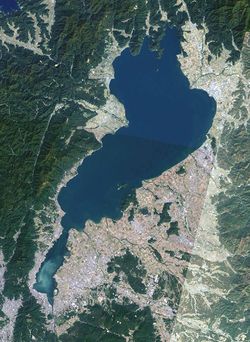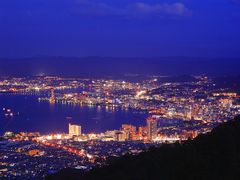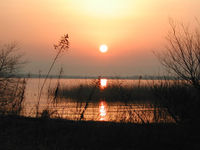Lake Biwa
| Lake Biwa 琵琶湖 |
|
|---|---|
 |
|
| from space | |
| Primary inflows | more than 400 small rivers |
| Primary outflows | Seta river |
| Catchment area | 3174 km² |
| Basin countries | Japan |
| Max. length | 63.49 km |
| Max. width | 22.8 km |
| Surface area | 670.4 km² |
| Max. depth | 103.58 m |
| Water volume | 27.5 km³ |
| Residence time | 5.5 years |
| Shore length1 | 235.2 km |
| Surface elevation | 85.6 m |
| Islands | 3 |
| Settlements | Hikone, Otsu, Sakamoto |
| 1 Shore length is not a well-defined measure. | |
Lake Biwa (琵琶湖 Biwa-ko), formerly known as Ōmi (淡海) Lake, is the largest freshwater lake in Japan, located in Shiga Prefecture (west-central Honshū), northeast of the former capital city of Kyoto. Because of its proximity to the ancient capital, references to Lake Biwa appear frequently in Japanese literature, particularly in poetry and in historical accounts of battles.
Contents |
Area and use
The area of this lake is about 670 km², making it larger than Awaji Island. Small rivers drain from the surrounding mountains into Lake Biwa, which serves as a reservoir for the cities of Kyoto and Ōtsu and is a valuable resource for nearby textile industries. It provides drinking water for about 15 million people in the region. Lake Biwa is a breeding ground for freshwater fish, including trout, and for the pearl culture industry.

The lake's surface rises as much as three metres in spring due to melting snow and spring rains, and in autumn after typhoon rains.
Its main outlet is the Seta River, which later becomes the Yodo River and flows into the Pacific Ocean at Osaka Bay near the said city.
The Lake Biwa Canal, built in the late 1890s and later expanded during the Taishō period played a role of great importance in the rekindling of Kyoto's industrial life, after a steep decline following the transfer of the capital to Tokyo.
Lake Biwa is home to many popular beaches along the southwestern shore, in particular, for example, Shiga Beach and Omi Maiko. The Mizunomori Water Botanical Garden is also of interest.
The body of water has a running competition named after it – the Lake Biwa Marathon – which takes place in Ōtsu near the lake annually.
Natural history of the lake
Lake Biwa is of tectonic origin and is one of the world's oldest twenty lakes, dating to almost 4 million years ago. This long uninterrupted age has allowed for a notably diverse ecosystem to evolve in the lake. Naturalists have documented about 1100 kinds of living things in the lake, including 58 endemic species, which means they are found nowhere else on earth. Lake Biwa is also an important place for water birds. About 5 thousand water birds visit Lake Biwa every year. Recently the biodiversity of the lake has suffered greatly due to the invasion of foreign fish, the black bass and the bluegill. Bluegill were presented to the Emperor and later freed in the lake as a food source for other fish. Black bass were introduced as a sport fish. In July 2009 a largemouth bass weighing 22 pounds, 4 ounces was caught in the lake by Manabu Kurita. It has been officially certified by the IGFA to tie the largemouth bass world record held solely by George Perry for 77 Years.
Environmental legislation protecting the lake
Various environmental laws cover Lake Biwa:
- Legislation to prevent eutrophication
This was enacted in 1981 and first enforced on July 1, 1982; therefore, this day is called "Lake Biwa Day" . The legislation established standards for the nitrogen and phosphorus levels for agricultural, industrial, and household water sources emptying into the lake. They also banned people from using and selling synthetic detergents which contain phosphorus.
- The Ramsar treaty

The lake was designated as a UNESCO Ramsar Wetland (1993) in accordance with the Ramsar Convention. The object of this treaty is to protect and sensibly use internationally valuable wetlands. The Kushiro marsh (釧路湿原, Kushiro Shitsugen) in Japan is under this treaty now.
- Shiga Ordinance for the Conservation of Reed Vegetation Zones
Reed colonies on the shore form give Lake Biwa its characteristic scenery. The reeds play an important role in purifying water as well as providing habitat for birds and fish. At one time there were large areas of reeds along the shores of Lake Biwa, which local government surveys recently found to have halved in size due to encroaching development. This ordinance to protect, grow, and utilize the reed beds has been in force since 1992.
See also
- Biwa, a stringed instrument, which has a similar shape to the lake.
- Birdman Rally (1977-), the yearly televised homemade glider and human-powered flight competition.
- F.C. Mi-O Biwako Kusatsu, football club based in Kusatsu, Shiga, facing the lake.